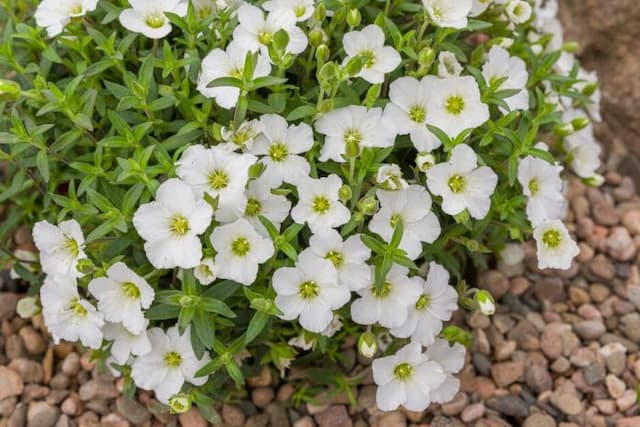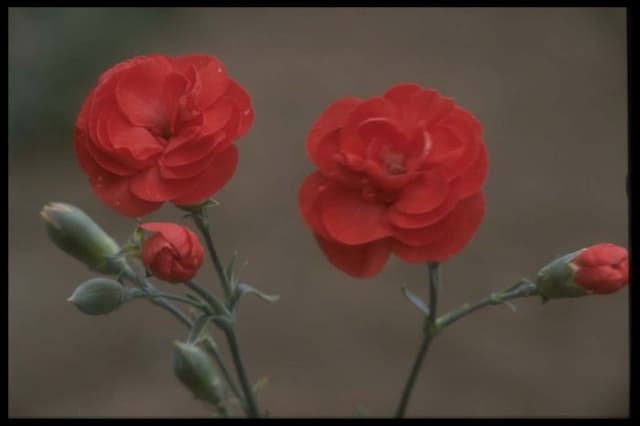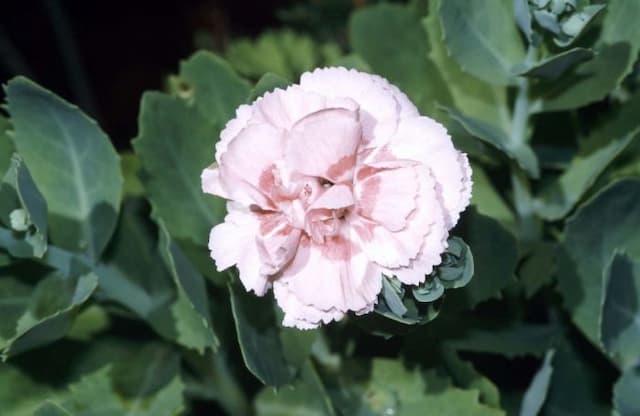Carnation Dianthus 'Oakwood Romance' (p)

ABOUT
The Dianthus 'Oakwood Romance' is a charming plant known for its distinctive and striking blooms. The flowers of this variety are well-regarded for their rich, velvety crimson hue, often characterized by a subtle overlay or dusting of a darker color that can create a smoldering appearance. These vibrant flowers typically feature a delightful pattern of concentric circles, which can include a lighter pink or even white at the very center, creating an eye-catching contrast against the darker petals. Each individual bloom is composed of frilly or ruffled edges that give the flowers a full, lush look, enhancing their romantic appeal. These frilled margins are a signature characteristic, contributing to their ornamental value in gardens and floral arrangements. The foliage of the Dianthus 'Oakwood Romance' is equally attractive, forming a dense clump or mat of narrow, lance-shaped leaves. These leaves are typically blue-green or gray-green in color, providing an excellent backdrop that further accentuates the brilliance of the flowers. Together, the combination of striking flowers and complementary foliage creates a visual symphony that is sure to captivate the senses of any onlooker. This plant has a tidy, mounding growth habit, which contributes to its neat appearance both in garden borders and as a standalone feature. It is favored by gardeners for adding a splash of color and elegance to various outdoor settings. The Dianthus 'Oakwood Romance' is not only celebrated for its beauty but also for its pleasing fragrance, which can be described as a blend of sweet and spicy notes, typical of many in its genus. This alluring scent often attracts pollinators to the garden, adding to the plant's list of desirable attributes.
About this plant
 Names
NamesFamily
Caryophyllaceae
Synonyms
Oakwood Romance Dianthus, Pink
Common names
Dianthus 'Oakwood Romance'
 Toxicity
ToxicityTo humans
The Dianthus 'Oakwood Romance', commonly known as Pinks, is generally considered non-toxic to humans. Therefore, it is not expected to cause poisoning if ingested. However, like with any plant material, individual sensitivities can occur, and consuming non-food plants is generally discouraged due to the potential risk of gastrointestinal discomfort or allergic reaction.
To pets
Pinks, the common name for Dianthus 'Oakwood Romance', are not known to be toxic to pets such as dogs and cats. Ingesting parts of the plant should not cause poisoning. Nonetheless, it is possible for pets to experience mild gastrointestinal upset if they consume a large amount of plant material, but this is not due to toxicity.
 Characteristics
CharacteristicsLife cycle
Perennials
Foliage type
Evergreen
Color of leaves
Blue-green
Flower color
Pink
Height
0.5 feet (15 cm)
Spread
1 foot (30 cm)
Plant type
Herb
Hardiness zones
5
Native area
Europe
Benefits
 General Benefits
General Benefits- Aesthetic Appeal: Adds color and beauty to gardens with its vibrant pink flowers and attractive foliage.
- Attracts Wildlife: Encourages visits from pollinators like bees and butterflies, which are beneficial for the ecosystem.
- Drought Tolerance: Once established, it has good drought resistance, requiring less water compared to other plants.
- Low Maintenance: Generally easy to care for and does not require a lot of attention, making it a great choice for gardeners of all levels.
- Long Flowering Period: Provides blooms from late spring to early fall, offering a prolonged display of color.
- Cold Hardy: Capable of surviving and thriving in cooler temperatures, making it suitable for various climates.
- Compact Size: Its smaller size makes it ideal for containers, borders, or small gardens where space is limited.
- Herbaceous Perennial: Comes back year after year, reducing the need to replant annually and providing a lasting addition to the garden.
- Garden Design Versatility: Its form and color can be incorporated into a variety of garden styles, including cottage and rock gardens.
 Medical Properties
Medical PropertiesThis plant is not used for medical purposes.
 Air-purifying Qualities
Air-purifying QualitiesThis plant is not specifically known for air purifying qualities.
 Other Uses
Other Uses- Edging for walkways or borders: The compact size and neat habit of Dianthus makes it a good choice for creating defined edges along paths or garden beds.
- Container gardening: Due to its moderate growth and vibrant colors, Dianthus can be grown in pots and containers to decorate balconies, decks, or patios.
- Rock gardens: Dianthus can thrive in the well-draining soil of a rock garden, adding splashes of color amongst the stones.
- Crafting potpourri: The scented blooms can be dried and used in making homemade potpourri to freshen indoor spaces.
- Culinary garnish: The petals of Dianthus are edible and can be used to add a pop of color and mild spicy flavor to salads or desserts.
- Dye production: Historically, some species of Dianthus have been used to produce a red dye for textiles.
- Companion planting: Dianthus can be used in the garden to complement other plants with its contrasting foliage and flowers.
- Creating fairy gardens: Due to their delicate appearance, Dianthus can be included in fairy garden designs to create a whimsical look.
- Butterfly and bee attractant: The flowers are known for attracting pollinators, adding ecological value to the garden.
- Victorian language of flowers: In the Victorian era, Dianthus was used to convey the message of love, making it a historical symbol for affection in bouquets.
Interesting Facts
 Feng Shui
Feng ShuiThe plant Carnation is not used in Feng Shui practice.
 Zodiac Sign Compitability
Zodiac Sign CompitabilityThe plant Carnation is not used in astrology practice.
 Plant Symbolism
Plant Symbolism- Durability: The name "Dianthus" comes from the Greek words "dios," meaning divine, and "anthos," meaning flower. The genus is known for its hardiness in various conditions, which can translate into the symbolism of durability and resilience.
- Affection: Carnations, the common name for Dianthus, are often associated with love and affection. Different colors of carnations can symbolize different forms of love, from passionate to platonic.
- Distinction: The ruffled appearance of carnation flowers is distinctive and can symbolize someone's uniqueness or a sense of personal pride.
- Devotion: Carnations have historically been used to signify devotion and loyalty between friends or lovers, often tied to the idea of a love that is enduring.
- Health and Energy: Due to their vibrant colors and long-lasting nature, carnations are sometimes used to symbolize good health and a zest for life.
 Water
WaterCarnations need to be watered thoroughly whenever the soil feels dry to the touch, generally once or twice a week depending on the weather and soil drainage. They prefer infrequent, deep watering to shallow, frequent watering, which encourages strong root development. During the hottest parts of the summer, you may need to water more frequently. When watering, aim for approximately one inch of water each time, which for a small to medium-sized garden equates to about 0.5 to 0.625 gallons. It's vital to avoid overwatering as carnations are prone to fungal diseases when left in soggy soil.
 Light
LightCarnations require full sun to thrive, which means they should receive at least six hours of direct sunlight per day. The best spot for these plants would be an area with unobstructed sunlight, avoiding shaded or partially shaded areas. If you are planting indoors, a south-facing window is usually the ideal location to ensure adequate light.
 Temperature
TemperatureCarnations prefer cooler temperatures and can generally withstand temperatures down to 20°F, though they do best in temperatures ranging from 50°F to 65°F. However, it’s important to keep them protected from harsh winter winds and excessively high temperatures above 85°F, which can be damaging to the plants. Ensuring proper mulching can help insulate the roots during colder months.
 Pruning
PruningPruning carnations encourages a bushier plant and more blooms. Deadheading, or the removal of spent flowers, should be done consistently throughout the blooming season to promote continuous flowering. In addition, cut back the stems by one-third to one-half after the first significant bloom to rejuvenate the plant for additional blooming cycles. The best time for major pruning is in spring, just before new growth starts.
 Cleaning
CleaningAs needed
 Soil
SoilCarnation 'Oakwood Romance' thrives in a well-draining, fertile loam with a slightly alkaline pH between 6.7 and 7.5. The best soil mix for this plant is a blend of two parts garden soil, one part coarse sand or perlite, and one part well-rotted compost or peat moss to enrich the soil and ensure good drainage.
 Repotting
RepottingCarnations like 'Oakwood Romance' generally need to be repotted every 2-3 years or when they become root-bound. The best time to repot these plants is in the spring or early summer to give them time to establish in their new container before the winter.
 Humidity & Misting
Humidity & MistingCarnation 'Oakwood Romance' tolerates average humidity conditions and does not require any special humidity adjustments. It is well-suited to the typical humidity levels found in most home and garden environments without the need for extra measures.
 Suitable locations
Suitable locationsIndoor
Place Carnation 'Oakwood Romance' in bright, indirect light indoors.
Outdoor
In full sun to partial shade, Carnation 'Oakwood Romance' blooms best.
Hardiness zone
5-9 USDA
 Life cycle
Life cycleDianthus 'Oakwood Romance', commonly known as pinks or garden pinks, begins its life cycle when a seed germinates typically in spring. The seedling develops into a young plant with a rosette of leaves at ground level, and as it matures, it forms a sturdy stem. Throughout the growing season, the plant experiences vegetative growth and forms dense clumps with bluish-green, grass-like foliage. Flowering occurs in late spring to early summer, with the plant producing fragrant pink flowers with a frilled or serrated edge. After pollination, usually by bees or butterflies, the plant creates seed pods that ripen and eventually release seeds for the next generation. Post-blooming, the plant may enter a period of dormancy in late fall or winter, particularly in colder climates, and will resume growth and flowering in the following spring.
 Propogation
PropogationPropogation time
Spring-Early Summer
Propogation: Dianthus 'Oakwood Romance', commonly known as Pinks, is best propagated using the stem cutting method. This is typically done in late spring or early summer when the plant is actively growing. To propagate, take a healthy, non-flowering stem approximately 4 to 6 inches long (10 to 15 cm) and strip the leaves from the lower half. Dip the cut end into rooting hormone powder to encourage root development. Plant the cutting into a pot filled with a mix of half perlite and half peat moss to ensure good drainage and moisture retention. Keep the soil moist but not water-logged, and place the pot in a warm location with indirect sunlight. Roots usually develop within 2 to 3 weeks, after which the new plant can be transferred to a larger pot or into the garden.



![Pink [Tequila Sunrise]](/_next/image?url=https%3A%2F%2Fplants-admin.emdemapps.com%2Fimages%2Fplants%2F%2Fimages%2F604b5d995d06e.png&w=640&q=75)





